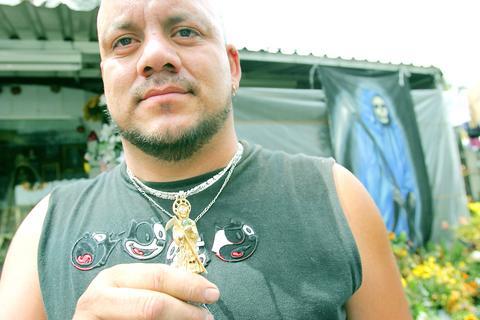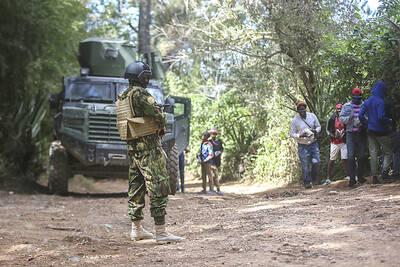In Mexico, the world's second-biggest Catholic country, an unofficial cult of death is winning followers, from influential politicians and police officers to drug pushers and violent criminals.
On a sidewalk in Mexico City's lawless Tepito district, gangsters and ordinary housewives rub shoulders as they pay homage before a shrine to Santa Muerte, or Saint Death, leaving offerings of colored candles, cigarettes and alcohol.
A statue of the unorthodox saint cuts a ghoulish figure as a life-size skeleton in a glittering robe, a tiara atop her long-haired wig and bony fingers laden with gold rings and money offerings in many currencies.

PHOTO: REUTERS
"I ask her to look after me in my businesses and to rid me of my envious thoughts," said Roberto Gutierrez, a tough-looking street hawker in sunshades. Gutierrez stops by the shrine every day and carries a prayer to Santa Muerte in his wallet.
Like many Santa Muerte wor-shippers, Gutierrez asks God's permission to pray to Death, unconcerned by the contradiction between practicing Christianity and a growing pagan cult, which is experiencing a revival after lying dormant until the 1960s.
"First for me comes God and then Santa Muerte," he said.
Before her glass casing, followers deposit apples and eggplants to symbolize abundance, flowers, glasses of tequila and half-smoked cigarettes. Some blow cigar smoke over her image in a cleansing rite.
"She likes it when we do that. She likes the smell of tobacco," said Enriqueta Romero, who tends the shrine.
A funeral cortege of gangsters sporting shades and gold chains passed by in gleaming cars, music blaring, saluting the shrine as they went.
"People ask her: `Protect me tonight because I am going to kidnap or assault somebody,'" said Mexican writer and poet Homero Aridjis, who documented this thriving cult in a book of fictional stories called "Santa Muerte."
The title story is based on a debauched birthday party Aridjis attended of a powerful politician with links to drug traffickers.
At the host's lavish ranch, where former beauty queens plied guests with alcohol and cocaine, Aridjis says he witnessed members of Mexico's political and business elite worship at a secret altar to Santa Muerte -- his first encounter with the phenomenon.
PAGAN DEVOTION
Mexicans have long had a complex relationship with death. Ancient indigenous cultures worshipped a god of death called Mictlantecuhtli, and the Aztecs believed mass human sacrifice was vital to feed the gods and keep the life cycle going.
Even after the Spanish conquest brought Catholicism to the region, Mexicans retained a strong pagan devotion to death, as seen by their celebration every November of the Day of the Dead when they erect altars to the dead in their homes and prepare elaborate meals for the departed souls. It is akin to Roman Catholics' observation on Nov. 2 of All Souls' Day, when they pray for the souls of the faithful departed.
"The cult to Santa Muerte is a syncretism between the Catholic Church and pre-Colombian worship of death," Aridjis said.
Halloween, originally a Celtic pagan feast of the dead to mark the end of the harvest and start of winter, is celebrated in the US and parts of Europe, mainly as a commercial holiday.
The cult of Santa Muerte has seen a revival in the past decade, a revival which Aridjis attributes to disillusionment with "the system."
"There is a complete disappointment with the government, people can't expect anything from the politicians, the parties or the established Church," he said.
A shrine to the Virgin of Guadalupe, Mexico's beloved dark-skinned version of Mary, stands on the next street corner from the macabre Tepito shrine.
"Santa Muerte is a saint like any other. She performs many miracles," said shaven-headed taxi driver Eduardo Ruben Villegas, 35, who sports multiple tattoos and has an altar in his home to Santa Muerte.
He has been a devotee since she cured his sister of cancer, he said.
Villegas has an image of Santa Muerte hanging from the rear view mirror of his taxi, on his car keys and on three pendants he wears around his neck.
"She protects me a lot in my car. I haven't ever been assaulted," he said.
PAYING RESPECTS
On the first day of every month, hundreds of devotees line up around the block to pay their respects to the skeletal saint, who with her scythe resembles the Grim Reaper.
Romero changes Santa Muerte's dress before each monthly ceremony, at which mariachis serenade her in a celebration of death and life.
The offerings multiply and followers light different colored candles -- red for love, white for protection and black to do harm to an enemy.
Romero also leaves out food daily for the grinning figurine -- tamales, or corn dumplings, "for breakfast" and quesadillas and other treats later in the day.
Police presence is rare in Tepito, where drugs, firearms and smuggled goods are peddled freely.
But there is an unspoken rule that at Santa Muerte's shrine, worshippers pray in safety by day and by night and Romero asks no questions of them.

DITCH TACTICS: Kenyan officers were on their way to rescue Haitian police stuck in a ditch suspected to have been deliberately dug by Haitian gang members A Kenyan policeman deployed in Haiti has gone missing after violent gangs attacked a group of officers on a rescue mission, a UN-backed multinational security mission said in a statement yesterday. The Kenyan officers on Tuesday were on their way to rescue Haitian police stuck in a ditch “suspected to have been deliberately dug by gangs,” the statement said, adding that “specialized teams have been deployed” to search for the missing officer. Local media outlets in Haiti reported that the officer had been killed and videos of a lifeless man clothed in Kenyan uniform were shared on social media. Gang violence has left

US Vice President J.D. Vance on Friday accused Denmark of not having done enough to protect Greenland, when he visited the strategically placed and resource-rich Danish territory coveted by US President Donald Trump. Vance made his comment during a trip to the Pituffik Space Base in northwestern Greenland, a visit viewed by Copenhagen and Nuuk as a provocation. “Our message to Denmark is very simple: You have not done a good job by the people of Greenland,” Vance told a news conference. “You have under-invested in the people of Greenland, and you have under-invested in the security architecture of this

Japan unveiled a plan on Thursday to evacuate around 120,000 residents and tourists from its southern islets near Taiwan within six days in the event of an “emergency”. The plan was put together as “the security situation surrounding our nation grows severe” and with an “emergency” in mind, the government’s crisis management office said. Exactly what that emergency might be was left unspecified in the plan but it envisages the evacuation of around 120,000 people in five Japanese islets close to Taiwan. China claims Taiwan as part of its territory and has stepped up military pressure in recent years, including

UNREST: The authorities in Turkey arrested 13 Turkish journalists in five days, deported a BBC correspondent and on Thursday arrested a reporter from Sweden Waving flags and chanting slogans, many hundreds of thousands of anti-government demonstrators on Saturday rallied in Istanbul, Turkey, in defence of democracy after the arrest of Istanbul Mayor Ekrem Imamoglu which sparked Turkey’s worst street unrest in more than a decade. Under a cloudless blue sky, vast crowds gathered in Maltepe on the Asian side of Turkey’s biggest city on the eve of the Eid al-Fitr celebration which started yesterday, marking the end of Ramadan. Ozgur Ozel, chairman of the main opposition Republican People’s Party (CHP), which organized the rally, said there were 2.2 million people in the crowd, but